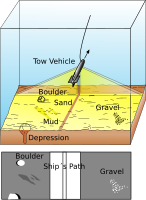
Photo from wikipedia
The underwater environment is complicated and changeable and contains many noises, making it difficult to detect a particular object in the underwater environment. At present, the main seabed detection technology… Click to show full abstract
The underwater environment is complicated and changeable and contains many noises, making it difficult to detect a particular object in the underwater environment. At present, the main seabed detection technology explores the seabed environment with sonar equipment. However, the characteristics of underwater sonar imaging (e.g., low contrast, blurred edges, poor texture, and unsatisfactory quality) have serious negative influences on such image classification. Therefore, in this study, we propose a dual-path deep residual “shrinkage” network (DP-DRSN) module, which is a simple and effective neural network attention module that can classify side-scan sonar images. Specifically, the module can extract background and feature texture information of the input feature mapping through different scales (e.g., global average pooling and global max pooling), whereas scale information passes through a two-layer 1 × 1 convolution to increase nonlinearity. This helps realize cross-channel information interaction and information integration simultaneously before outputting threshold parameters in a sigmoid layer. The parameters are then multiplied by the average value of the input feature mapping to obtain a threshold, which is used to denoise the image features using the soft threshold function. The proposed DP-DRSN study provided higher classification accuracy and efficiency than other models. In this way, the feasibility and effectiveness of DP-DRSN in image classification of side-scan sonar are proven.
Journal Title: Computational Intelligence and Neuroscience
Year Published: 2022
Link to full text (if available)
Share on Social Media: Sign Up to like & get
recommendations!